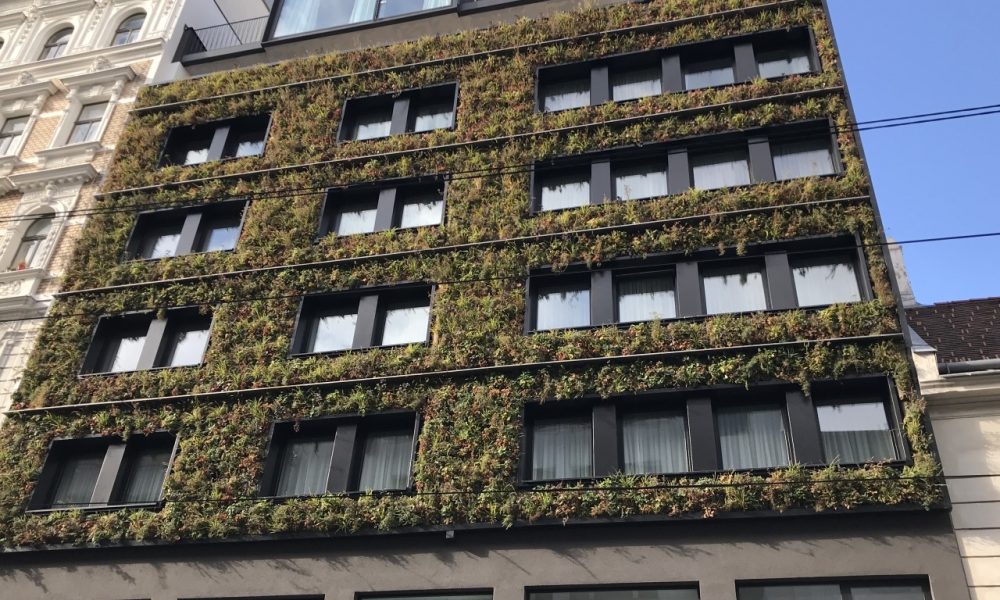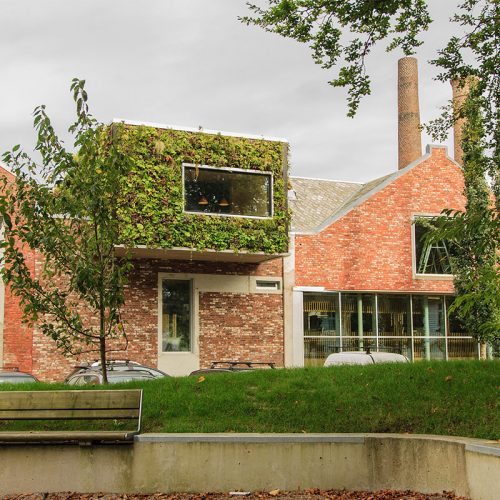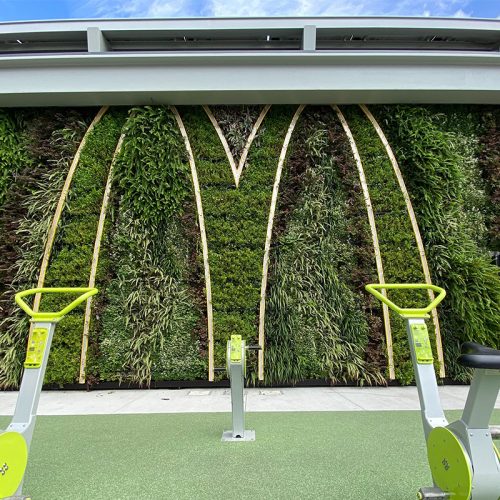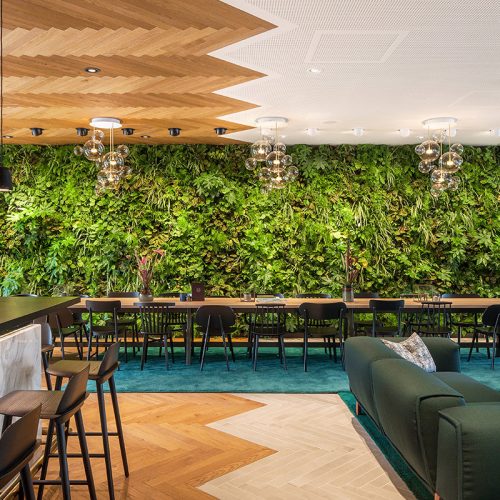Transport emissions in the EU have increased by 33% since 1990, while emissions in other sectors have decreased by 32%. In 2018, the combined emissions from domestic and international transport accounted for 29% of the total greenhouse gas emissions across the entire economy in the EU. Half of them was due to passenger cars and vans. On the other hand, the EU has the ambition to become climate neutral from 2050 onwards. Alas, until then, tons of exhaust fumes and harmful substances will still be released into the air every year. Fortunately, living walls can help counteract this. When placed in car parks or noise barriers, these plant walls have several other benefits besides reducing CO2 and exhaust fumes.
Cleaner air, in and around the car park
The main benefit of living walls in and on car parks is that they can help reduce the effects of exhaust fumes. In and around car parks, there’s a stream of cars all day long, emitting a range of pollutants into the air. These pollutants can be harmful to human health and the environment, contributing to problems such as smog and climate change.
However, plants have the ability to absorb some of these pollutants and help purify the air. Studies have shown that certain plant species are particularly effective at removing pollutants such as carbon monoxide, nitrogen dioxide and volatile organic compounds (VOCs) from the air. By installing living walls in or on car parks, we can create a natural barrier between exhaust gases and the environment, which helps improve air quality. This kind of green intervention is a great way of pollution mitigation.
All plants need carbon dioxide (CO2) to grow and stay alive. Plants convert CO2 into glucose, a very important building material and energy carrier. They then excrete oxygen as waste, which in turn is essential for humans and animals to breathe.
So plants like some of the substances we want to get rid of. By applying green facades in places where there’s a lot of traffic, we capture these substances directly where they are emitted.

The car park of the future: functional, comfortable and aesthetic
According to a new United Nations report, two in three people are likely to live in cities by 2050, highlighting the need for more sustainable urban planning and public services. In many cities, driving is made increasingly unattractive. It therefore makes sense that more parking should be created outside city centres. Compared to public parking spaces, car parks are a space-saving solution. Only, for both users and local residents it is important that a parking garage looks attractive. The parking garage of the future should be designed with functionality, comfort and aesthetics in mind. Applying elements such as green roofs, living walls and visually attractive architectural delights that complement the surrounding residential area.
How parking garages can be an important addition to the urban environment
Many car parks are unattractive spots in urban zones. Below, we show how this can be changed.
1. Parking garage Stadshart Zoetermeer, the Netherlands
In collaboration with Unibail Rodamco and the municipality of Zoetermeer, Sempergreen took a major step towards making shopping centre Stadshart in Zoetermeer more sustainable in 2012. A green facade covering an area of 274m2 was installed on the centre’s parking garage, which was previously grey and drab. Composed of 686 pre-cultivated Flexipanels, the green facade offers a sustainable solution in all its facets. An important criterion for the client was that the facade should be water-saving. The SemperGreenwall was therefore chosen, as an internet-controlled irrigation system optimises its water use. By using plants with different leaf types, the facade gets a beautiful colour variation throughout the seasons and the vertical greenery provides a pleasant view for the living environment around the car park.


To give the car park in The Hague a natural look, a green wall was installed. The SemperGreenwall Outdoor covers an area of 190 m2 and is located next to an indoor garden. The facade is supplied with sufficient water and nutrients through an automatic irrigation system, keeping the plants in optimal condition throughout the year. Besides beautifying the car park, this green wall also contributes to the greening of The Hague, increases the city’s biodiversity and improves the local air quality.
To give the car park in The Hague a natural look, a green wall was installed. The SemperGreenwall Outdoor covers an area of 190 m2 and is located next to an indoor garden. The facade is supplied with sufficient water and nutrients through an automatic irrigation system, keeping the plants in optimal condition throughout the year. Besides beautifying the car park, this green wall also contributes to the greening of The Hague, increases the city’s biodiversity and improves the local air quality.
To give the car park in The Hague a natural look, a green wall was installed. The SemperGreenwall Outdoor covers an area of 190 m2 and is located next to an indoor garden. The facade is supplied with sufficient water and nutrients through an automatic irrigation system, keeping the plants in optimal condition throughout the year. Besides beautifying the car park, this green wall also contributes to the greening of The Hague, increases the city’s biodiversity and improves the local air quality.
In short, living walls in and around car parks are an innovative and sustainable solution to improve air quality, regulate temperature and enhance the aesthetic appeal of urban spaces. They can have significant environmental and community benefits, and should be considered as a tool for future urban development.
Green and energy-neutral parking experience
Besides installing a green facade on your car park, you can also install a green roof on the garage. Installing a green roof on a car park offers many advantages. First, it contributes to biodiversity in the city, as the green roof provides a habitat for various plants and animals. In addition, a green roof reduces heat in the city by absorbing and retaining the sun’s rays instead of reflecting them. This not only reduces the heat island effect, but also saves energy costs for cooling the car park. Moreover, a green roof improves air quality in the city by filtering particulates from the air and absorbing CO2. Finally, it helps to reduce rainwater flooding in the city, as the green roof acts as a buffer for rainwater, thus reducing the burden on the sewage system.
Wondering what Sempergreen can do for you?
Do you wish to green your car park and make your visitors’ parking experience more pleasant? Get in touch with our experts. They will be happy to help you out!











